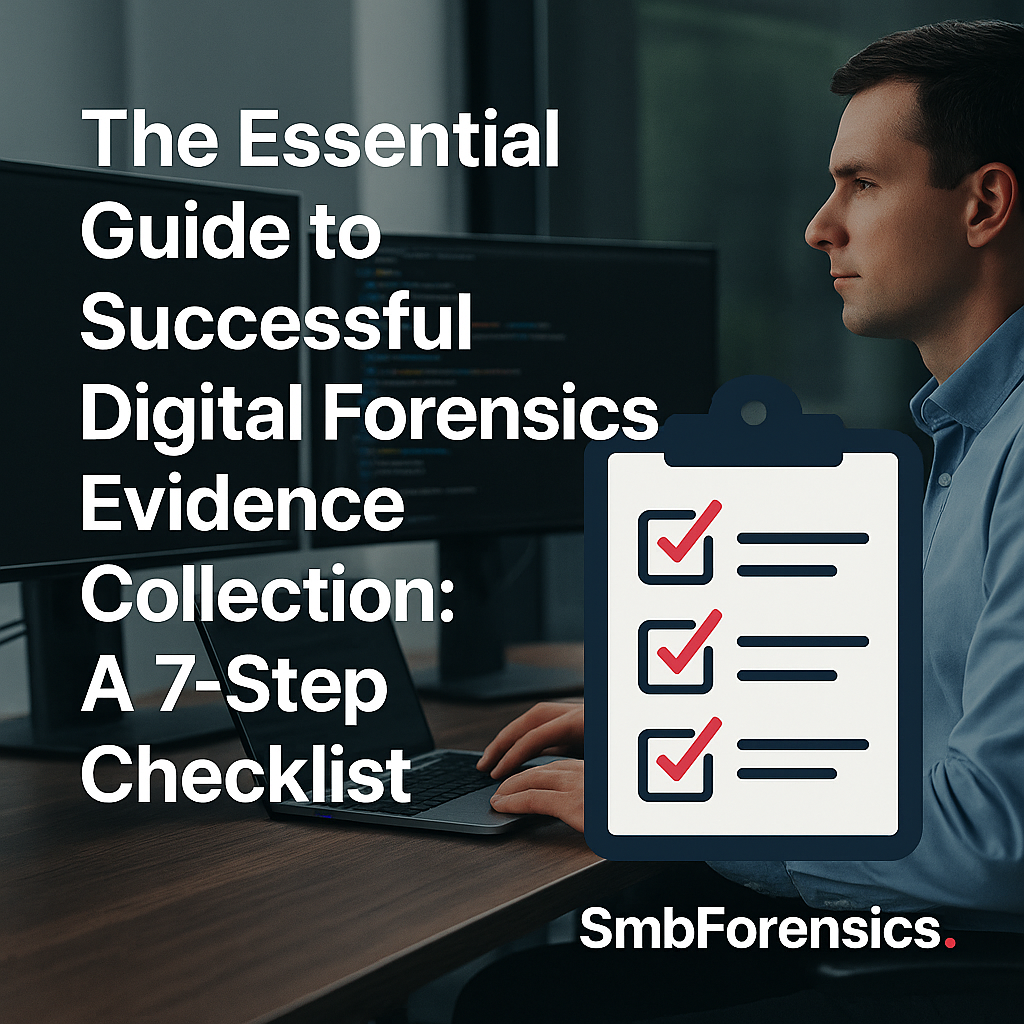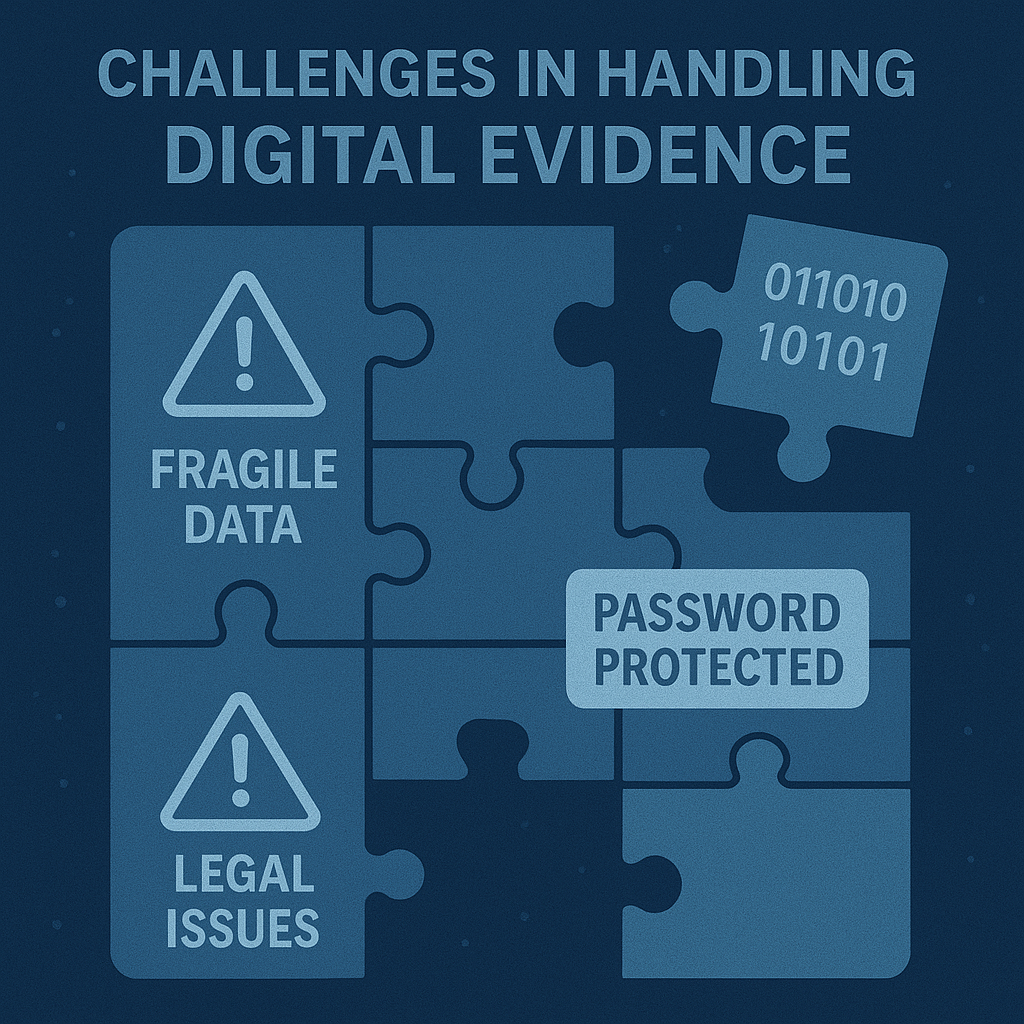
Unlocking Digital Evidence: A Comprehensive Guide
This guide walks you through each step of the digital forensics evidence collection process, including recommended tools, techniques, and reporting.
In today’s hyper-connected world, cybercrime has become a significant threat, affecting not just multinational corporations but also small businesses, government entities, and individuals. Whether it’s ransomware, data theft, or unauthorized access, investigating these incidents requires a precise and systematic approach.
For a complete response plan, check out our Digital Incident Response Guide.
At the heart of these investigations lies the process of digital forensics evidence collection—the practice of retrieving, preserving, and analyzing digital data in a way that upholds its legal and technical integrity. This expert guide walks you through essential methods, tools, and procedures that can turn chaotic digital data into legally admissible and actionable evidence.
For a stronger response plan, explore our Incident Response Guide.
If you haven’t already, explore how to build an incident response plan to pair with your digital forensics capabilities.
To strengthen your cybersecurity process alongside digital evidence handling, check out our Incident Response Plan Guide.
What Is Digital Forensics Evidence Collection?
Digital forensics evidence collection refers to the practice of identifying, acquiring, preserving, examining, and documenting digital data from various sources. These can include personal computers, smartphones, cloud platforms, network routers, and more.
Digital evidence is fundamentally different from physical evidence—it is highly volatile and easy to manipulate or destroy. This makes precise handling vital. If collected or processed incorrectly, digital evidence can become inadmissible in court or useless for analysis.
According to the NIST SP 800-101, the key principles include maintaining data integrity, ensuring repeatability of results, and securing a documented chain of custody throughout the process.
For a downloadable form and best practices, read our Chain of Custody Template for Digital Evidence.

Why Is Digital Forensics Evidence Collection So Important?
Effective collection isn’t just a technical procedure—it’s a legal and operational safeguard. Here’s why:
- Preserving Integrity: Evidence must be preserved in its original state to avoid claims of tampering.
- Legal Admissibility: Only forensically sound data can be used in courts. Chain of custody and documentation are key.
- Understanding Events: Helps reconstruct what happened, when, how, and by whom.
- Supporting Legal Claims: Enables prosecution or defense in both civil and criminal cases.
- Incident Resolution: Allows teams to respond to and recover from security events more efficiently.
A poor evidence collection process can result in loss of critical information, regulatory non-compliance, or legal dismissal of the entire investigation.
The 7-Step Checklist for Digital Forensics Evidence Collection
1. Identify Potential Evidence Sources
Begin by mapping out all possible data sources relevant to the incident. These may include:
- Workstations and laptops
- Servers (on-premise or cloud-based)
- USB drives and external disks
- Email servers and messaging platforms
- Mobile devices (smartphones, tablets)
- Network hardware like routers, firewalls, and switches
Example: If investigating insider threats, reviewing employee desktops, communication logs, and access history from Active Directory might be essential.
Use a triage approach: prioritize sources based on likelihood of containing relevant data and volatility.
2. Secure the Environment
Before evidence acquisition, it’s critical to stabilize the digital environment:
- Disconnect compromised devices from networks to prevent remote tampering or malware spread
- Take photographs or screenshots of open sessions or running processes
- Use write-blockers on storage media to avoid unintentional data changes
- Record timestamps and system states
This phase is where most forensic mistakes are made—preserving the system “as-is” is essential to the integrity of everything that follows.
3. Acquire Data Forensically
Acquisition is the process of creating an exact bit-by-bit copy of digital media without modifying the original.
Best Practices:
- Use industry-standard tools like FTK Imager, EnCase, or Autopsy
- Create forensic images rather than copying files individually
- Record hash values before and after imaging for verification
- Document everything: date/time, personnel, tools used, target system details
- Always hash and verify every file during digital forensics evidence collection to detect tampering and confirm authenticity.
In some cases, especially with cloud platforms, you may need to work with providers or APIs to collect data in a compliant way.
4. Maintain a Chain of Custody
Chain of custody is your legal proof of proper evidence handling. It details:
- Who collected the evidence
- When it was collected
- Where it was stored
- Who accessed it, when, and why
Use a standardized custody form and have all handlers sign and timestamp each handoff. Store evidence in secure containers and limit access to authorized personnel only.
Explore more on how to manage chain of custody effectively.
5. Analyze Digital Evidence
Now comes the forensic analysis phase:
- Recover deleted or hidden files using forensic recovery tools
- Identify malicious software or scripts
- Trace file access logs to uncover insider threats
- Reconstruct browsing histories and user activity timelines
- Review log files, including login attempts, file transfers, and remote sessions
You may use tools like Volatility for memory analysis and Wireshark for packet-level inspection.
The goal is to extract meaningful patterns, sequences, or anomalies that support your hypothesis or explain the incident.
6. Report the Findings Clearly
Create a structured, detailed, and reader-friendly report. It should include:
- Overview of the incident
- Methodologies used for collection and analysis
- Findings supported by screenshots, logs, or hash values
- Timelines and event reconstructions
- Implications and recommendations
Reports are often reviewed by legal teams, executives, or regulators—so clarity, accuracy, and simplicity are key.
7. Hash and Verify All Evidence
Hashing ensures that your evidence hasn’t been modified:
- Use algorithms like SHA-256 or SHA-512
- Generate a hash at the point of acquisition
- Recalculate the hash before every access or analysis
- Document all hash values in the report
Any change in hash indicates potential tampering—this step protects the evidence and your credibility.
Essential Tools for Digital Forensics
| Tool | Purpose |
|---|---|
| FTK Imager | Creates bit-by-bit forensic images |
| EnCase | In-depth disk analysis, metadata recovery, file carving |
| Autopsy | Open-source graphical front-end for analysis |
| Wireshark | Captures and decodes network traffic |
| Cellebrite | Mobile device data extraction and analysis |
| Volatility | RAM memory analysis, malware discovery |
| John the Ripper | Password cracking for encrypted files |
Challenges in Digital Forensics Evidence Collection
- Encryption: Requires decryption keys or password-cracking tools
- Cloud Storage: Often requires legal cooperation or specific APIs
- Sheer Data Volume: Use filtering and keyword search to manage scope
- Volatile Data: RAM and open sessions must be captured fast
- Jurisdictional Laws: Especially when handling data across borders
Stay up to date with ISO/IEC 27037 for digital evidence handling standards.
Best Practices to Follow
- Use write blockers when handling physical storage devices
- Follow NIST and ISO guidelines strictly
- Perform periodic dry runs or simulations of incident response
- Hash every evidence file before and after each stage
- Log every step in a forensic activity report
- Use encryption when storing sensitive evidence long-term
- Always analyze copies, never originals
Internal Resources for Further Learning
- How to Build a Digital Incident Response Plan
- Understanding Chain of Custody in Cyber Investigations
- Cybersecurity Fundamentals for IT Teams
External Reference Links
- NIST Guide to Integrating Forensic Techniques into Incident Response
- EnCase Forensic Software
- ISO 27037 Overview
- FTK Imager Tool
Conclusion
Digital forensics evidence collection is not just a technical discipline—it’s a legal and investigative cornerstone. By following the correct processes, using certified tools, and maintaining meticulous documentation, organizations can uncover, preserve, and present digital evidence with full confidence in its integrity and admissibility.
Effective digital forensics evidence collection is a cornerstone of cybersecurity investigations, ensuring data remains secure, preserved, and legally sound.
As cyber threats grow in scale and complexity, mastering these forensic techniques is no longer optional—it’s a necessity.




Leave a Reply